What Does 'Fleet of Foot' Mean? English Guide

Written by
Ernest Bio Bogore

Reviewed by
Ibrahim Litinine
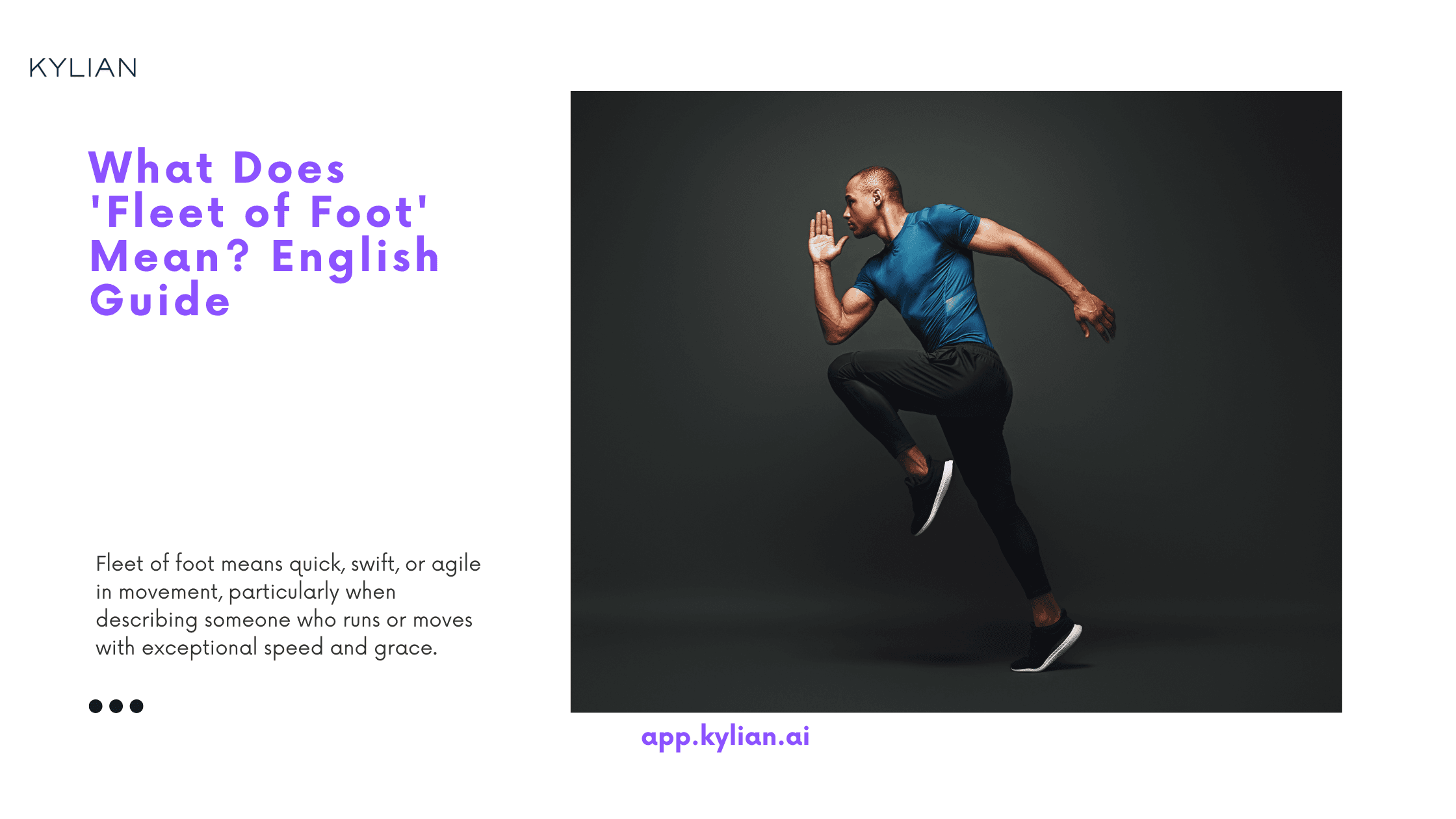
The phrase "fleet of foot" represents one of English's most enduring idioms, yet its meaning often eludes modern speakers. Understanding this expression matters because it reveals how language evolves while maintaining connections to our cultural heritage. More critically, mastering such idioms enhances your ability to decode literature, news, and sophisticated discourse where these phrases appear without explanation.
Fleet of foot means quick, swift, or agile in movement, particularly when describing someone who runs or moves with exceptional speed and grace. The expression transcends mere velocity—it captures the elegance and efficiency of rapid movement, distinguishing between raw speed and refined quickness.
Etymology and Historical Origins of Fleet of Foot
The word "fleet" derives from Old English "flēot," meaning swift or quick, sharing roots with the verb "to fleet" (to move swiftly). This connection to maritime language proves significant—the same root that describes fast-moving ships applies to human agility. The phrase gained prominence in Middle English literature, where poets frequently employed it to describe heroes, messengers, and mythological figures.
Historical usage reveals fascinating patterns. Medieval chronicles used "fleet of foot" to describe military scouts and royal messengers, roles where speed determined success or failure. The phrase appeared in official court documents, suggesting it carried formal weight beyond poetic flourish. This practical application explains why the idiom survived centuries of linguistic change—it served functional communication needs.
Archaeological evidence from medieval manuscripts shows the phrase appeared alongside tactical military descriptions, indicating that "fleet of foot" represented a measurable, valuable skill rather than mere literary decoration. Warriors described as fleet of foot received higher compensation and more prestigious assignments, demonstrating the economic value placed on this attribute.
Modern Usage and Contemporary Applications
Today's usage extends beyond physical description to encompass mental agility and adaptability. Business leaders described as "fleet of foot" demonstrate quick decision-making and rapid response to market changes. This semantic expansion reflects our economy's shift from physical to intellectual labor, where cognitive speed matters more than physical velocity.
Sports commentary frequently employs this phrase, particularly in track and field, soccer, and basketball coverage. Broadcasters use "fleet of foot" to distinguish between players who simply run fast and those who move with strategic intelligence. The phrase implies purposeful movement rather than frantic rushing.
Digital communication has created interesting applications. Social media influencers described as "fleet of foot" adapt quickly to platform changes and trending topics. This usage demonstrates how classical idioms find new relevance in technological contexts, bridging traditional expression with contemporary needs.
Literary and Cultural Significance
Classic literature extensively features "fleet of foot" characters, from Homer's Hermes to Shakespeare's messenger figures. These literary applications established cultural associations between speed and divine or heroic qualities. The phrase became shorthand for supernatural ability, elevating ordinary human movement to mythological status.
The cultural weight of "fleet of foot" extends beyond Western literature. Translation studies reveal similar concepts across languages—Japanese "hayaashi," Arabic "sarī' al-qadam," and Hindi "तेज़ पैर" (tez pair)—suggesting universal human fascination with exceptional speed and grace.
Contemporary authors continue using this phrase strategically. Mystery writers employ it for characters who escape danger, while fantasy authors apply it to magical beings. The persistence of this usage indicates that "fleet of foot" fulfills specific narrative functions that modern alternatives cannot replicate.
Grammatical Structure and Linguistic Analysis
The phrase follows an archaic English construction pattern: adjective + preposition + noun. This structure, common in older English, creates rhythm and emphasis that standard adjective-noun combinations lack. "Fleet of foot" carries more weight than "fast runner" because the prepositional phrase adds formality and specificity.
Linguistically, this construction parallels other English idioms: "light of heart," "quick of wit," "slow of speech." These phrases share medieval origins and formal register, suggesting they belonged to elevated discourse rather than casual conversation. Understanding this pattern helps decode similar expressions in literature and formal writing.
The grammatical persistence of such phrases reveals language's conservative tendencies. While contemporary English favors direct constructions, these archaic patterns survive in specific contexts where their formality and rhythm serve particular purposes. Legal documents, ceremonial speeches, and academic writing often employ such constructions for their authoritative tone.
Regional Variations and International Usage
British English maintains stronger attachment to "fleet of foot" than American English, appearing more frequently in BBC broadcasts and UK publications. This preference reflects British English's tendency to preserve traditional expressions longer than American variants.
Canadian and Australian English show intermediate usage patterns, employing the phrase in sports commentary and nature documentaries but rarely in business contexts. New Zealand English demonstrates unique applications, particularly when describing athletes in rugby and track events.
International English learners often struggle with this phrase because direct translation rarely captures its nuanced meaning. Educational materials frequently list it among "challenging idioms" that require cultural context rather than literal interpretation.
Synonyms, Alternatives, and Comparative Analysis
Modern alternatives include "quick on their feet," "fast runner," "speedy," and "agile." However, these substitutes lack the literary gravitas and cultural resonance of "fleet of foot." The original phrase implies not just speed but grace, purpose, and almost supernatural ability.
"Swift" comes closest to capturing the essence, sharing similar etymological roots and formal register. "Nimble" emphasizes agility over pure speed, while "rapid" suggests mechanical rather than organic movement. None perfectly replaces "fleet of foot" because they miss the phrase's poetic and cultural dimensions.
Comparative analysis reveals that "fleet of foot" occupies a unique semantic space. It bridges literal physical description with metaphorical suggestion, allowing writers to convey both factual information and atmospheric impression simultaneously. This dual function explains why the phrase persists despite having numerous alternatives.
Practical Applications in Modern Communication
Professional writing benefits from strategic "fleet of foot" usage. Business communications can employ it metaphorically to describe companies that adapt quickly to market changes. Academic writing uses it to characterize rapid historical developments or swift scientific advances.
Creative writing applications range from character description to pacing metaphors. The phrase works particularly well in historical fiction, fantasy, and adventure genres where its archaic flavor enhances atmosphere. Contemporary fiction writers use it sparingly for contrast and emphasis.
Public speaking situations where "fleet of foot" adds value include formal presentations, ceremonial addresses, and educational lectures. The phrase signals erudition and cultural awareness while maintaining accessibility to educated audiences.
Common Misconceptions and Usage Errors
Many speakers incorrectly use "fleet of foot" to describe any fast movement, missing its implications of grace and purpose. The phrase suggests controlled, efficient movement rather than desperate rushing. Applying it to frantic or clumsy behavior misses the essential quality of elegant speed.
Another common error involves using the phrase for non-human subjects inappropriately. While mythological creatures and exceptional animals might be "fleet of foot," applying it to vehicles or abstract concepts often creates awkward constructions that dilute the phrase's impact.
Pronunciation sometimes causes problems, with speakers emphasizing "fleet" when natural rhythm requires equal stress on both "fleet" and "foot." This error reduces the phrase's musicality and formal effectiveness.
Teaching and Learning Strategies
Effective instruction in "fleet of foot" usage requires historical context alongside modern applications. Students benefit from seeing the phrase in classical literature before encountering contemporary usage. This progression demonstrates semantic evolution while maintaining core meaning.
Practice exercises should include both literal and metaphorical applications. Students need experience applying the phrase to physical movement, character description, and abstract concepts. Comparative exercises with synonyms help clarify the phrase's unique qualities.
Cultural awareness activities enhance understanding by connecting the phrase to broader patterns of English idiom formation and preservation. Students who understand why certain phrases survive while others disappear develop better intuition for appropriate usage.
Learn Any Language with Kylian AI
Private language lessons are expensive. Paying between 15 and 50 euros per lesson isn’t realistic for most people—especially when dozens of sessions are needed to see real progress.

Many learners give up on language learning due to these high costs, missing out on valuable professional and personal opportunities.
That’s why we created Kylian: to make language learning accessible to everyone and help people master a foreign language without breaking the bank.
To get started, just tell Kylian which language you want to learn and what your native language is
Tired of teachers who don’t understand your specific struggles as a French speaker? Kylian’s advantage lies in its ability to teach any language using your native tongue as the foundation.
Unlike generic apps that offer the same content to everyone, Kylian explains concepts in your native language (French) and switches to the target language when necessary—perfectly adapting to your level and needs.

This personalization removes the frustration and confusion that are so common in traditional language learning.
Choose a specific topic you want to learn
Frustrated by language lessons that never cover exactly what you need? Kylian can teach you any aspect of a language—from pronunciation to advanced grammar—by focusing on your specific goals.
Avoid vague requests like “How can I improve my accent?” and be precise: “How do I pronounce the R like a native English speaker?” or “How do I conjugate the verb ‘to be’ in the present tense?”

With Kylian, you’ll never again pay for irrelevant content or feel embarrassed asking “too basic” questions to a teacher. Your learning plan is entirely personalized.
Once you’ve chosen your topic, just hit the “Generate a Lesson” button, and within seconds, you’ll get a lesson designed exclusively for you.
Join the room to begin your lesson
The session feels like a one-on-one language class with a human tutor—but without the high price or time constraints.
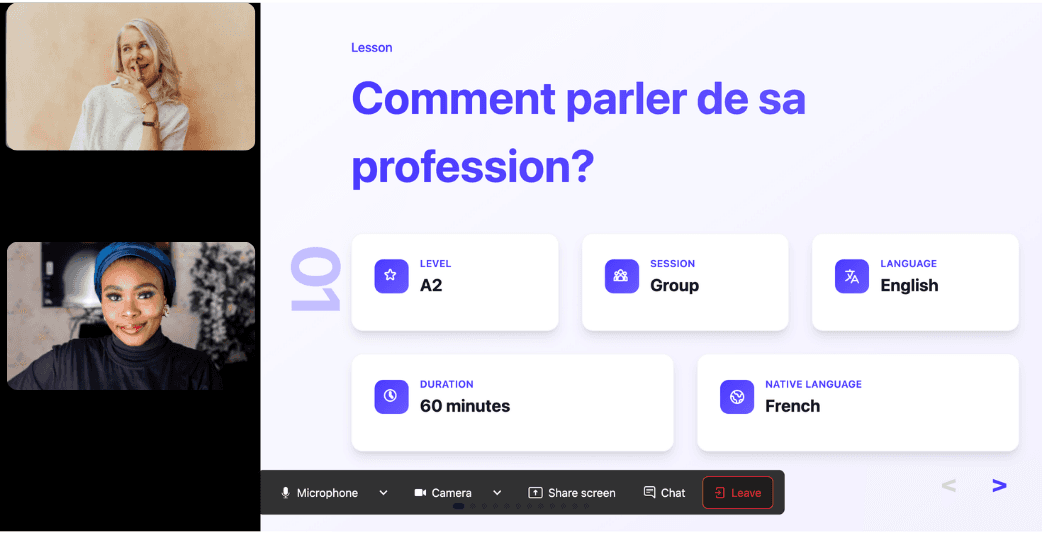
In a 25-minute lesson, Kylian teaches exactly what you need to know about your chosen topic: the nuances that textbooks never explain, key cultural differences between French and your target language, grammar rules, and much more.
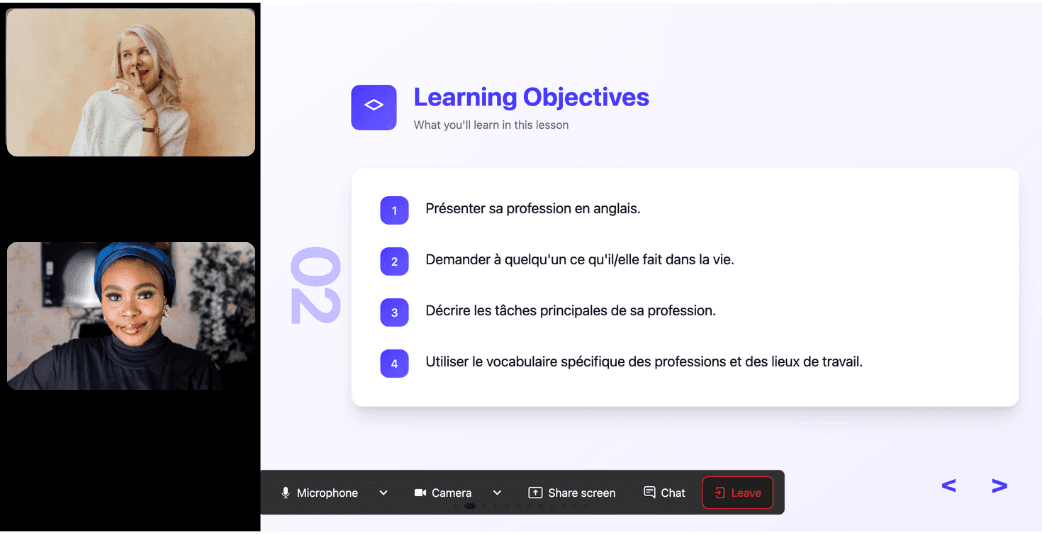
Ever felt frustrated trying to keep up with a native-speaking teacher, or embarrassed to ask for something to be repeated? With Kylian, that problem disappears. It switches intelligently between French and the target language depending on your level, helping you understand every concept at your own pace.
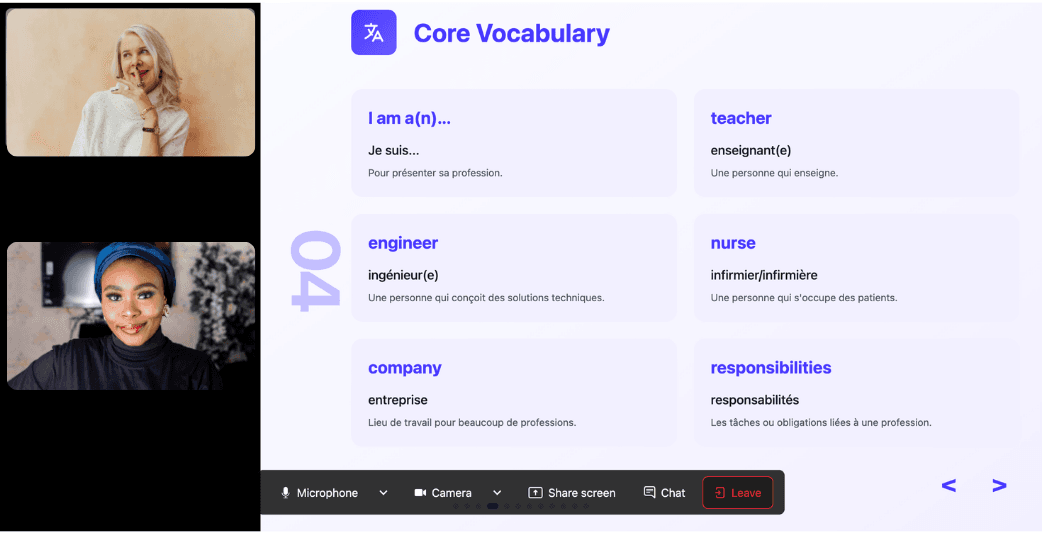
During the lesson, Kylian uses role-plays, real-life examples, and adapts to your learning style. Didn’t understand something? No problem—you can pause Kylian anytime to ask for clarification, without fear of being judged.
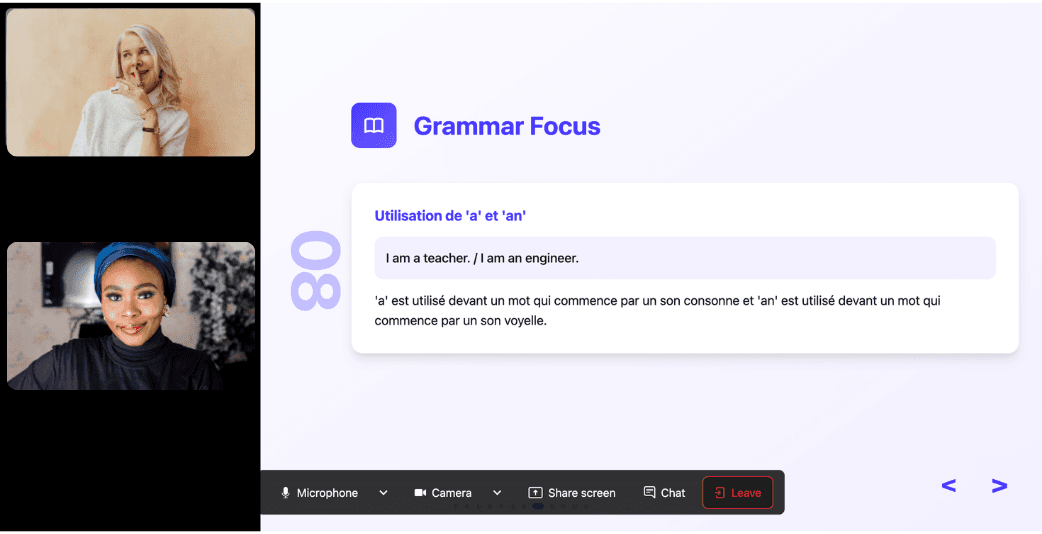
Ask all the questions you want, repeat sections if needed, and customize your learning experience in ways traditional teachers and generic apps simply can’t match.

With 24/7 access at a fraction of the cost of private lessons, Kylian removes all the barriers that have kept you from mastering the language you’ve always wanted to learn.
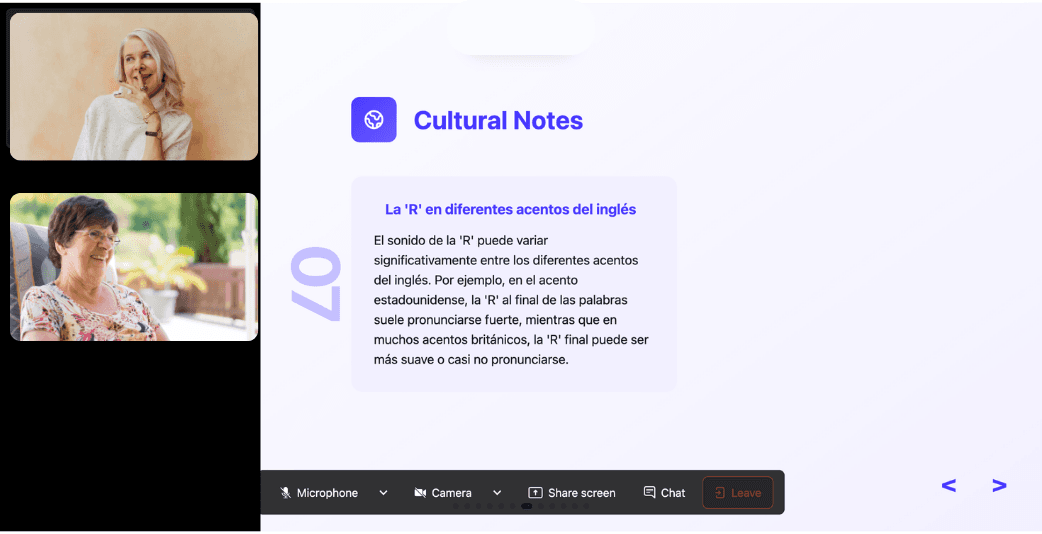
Similar Content You Might Want To Read

Could Care Less vs Couldn't Care Less: Which Is Correct?
The phrase "could care less" versus "couldn't care less" represents one of the most persistent grammatical debates in modern English. This linguistic confusion affects millions of speakers daily, yet the logical answer remains surprisingly clear-cut when examined through the lens of semantic meaning and historical usage. Understanding this distinction matters because language precision directly impacts communication effectiveness. When speakers use illogical constructions, they create unnecessary ambiguity that undermines their intended message. The stakes extend beyond casual conversation—professional communication, academic writing, and public discourse all suffer when fundamental expressions lack clarity.

"None of Us Is Perfect" vs "None of Us Are Perfect"
Grammar debates rarely spark heated discussions, yet the choice between "none of us is perfect" and "none of us are perfect" consistently divides English speakers across professional settings, academic institutions, and casual conversations. This distinction matters because it reflects deeper principles of subject-verb agreement that influence credibility in written communication. The stakes extend beyond mere correctness. Professional communications, academic papers, and formal presentations demand precision. When executives draft company-wide emails or researchers publish findings, grammatical accuracy directly impacts perceived competence and message clarity.

Recurrence vs Reoccurrence: What’s the Difference?
Language precision matters. The subtle distinctions between similar terms often separate clear communication from potential misunderstanding. Among these linguistic nuances, the pair "recurrence" and "reoccurrence" presents a particular challenge for English learners and native speakers alike. These terms appear interchangeable at first glance - both referring to something happening again. However, their usage patterns, connotations, and acceptance in formal English vary significantly. Understanding these differences enhances communication effectiveness across professional, academic, and everyday contexts. This comprehensive analysis explores the definitions, etymologies, and proper applications of both terms, offering clarity on when each is appropriate. We'll examine expert perspectives, usage statistics, and practical examples to provide a definitive guide for anyone seeking to communicate with greater precision.

Then vs Than: Master the Grammar Difference in English
The confusion between "then" and "than" represents one of the most persistent challenges in English grammar, affecting millions of writers daily. This distinction matters because these words serve fundamentally different grammatical functions, and misusing them undermines credibility in professional and academic contexts. Understanding this difference isn't just about avoiding embarrassment—it's about precision in communication. When we examine the data from grammar-checking software, "then/than" confusion ranks among the top five most common errors in business writing. This frequency suggests that mastering this distinction provides immediate, measurable improvement in written communication quality.

What is the Plural of Mango in English?
Language is fascinating in its complexities and nuances, particularly when examining the rules governing plural forms. While many English plurals follow predictable patterns, certain words present interesting variations—"mango" being one such example. Understanding these linguistic variations isn't merely academic; it's essential for precise communication in both casual conversations and formal writing.

All The Best vs Best of Luck: English Usage Guide
Language nuances shape how we express goodwill and encouragement. The seemingly interchangeable phrases "All the best" and "Best of luck" carry subtle differences that influence communication effectiveness in various contexts. Understanding these distinctions enables more precise expression and demonstrates cultural awareness in professional and personal interactions. This analysis examines when to use each phrase, contextual appropriateness, formality levels, and global variations - providing you with practical guidance for more intentional communication.